2017-03-30 - Nº 100
Editorial
Esta é a Newsletter Nº 100 que se apresenta com o mesmo formato que as anteriores. Se gostar da Newsletter partilhe-a!
Todas as Newsletters encontram-se indexadas no link.
Esta Newsletter tem os seguintes tópicos:
E passaram-se 100 semanas, foi em maio de 2015 que apareceu o primeiro número da Newsletter. Ao longo destes quase 2 anos foram apresentados mais de 2500 projectos, cerca de 1000 notícias, mais de 250 ebooks/revistas e cerca e 300 modelos 3D para imprimir. Vamos continuar a trazer o que os Internautas fazem aí pelo mundo. Foram feitas algumas alterações para melhorar a leitura da Newsletter. Esperemos que gostem.
No capitulo dos aniversários, faz hoje anos que nascia Robert Bunsen. A este químico alemão deve-se a descoberta do césio e do rubídio em conjunto com o físico Gustav Kirchhoff. Foi responsável pelo desenvolvimento de vários métodos de análise de gás, foi pioneiro em fotoquímica, e fez o trabalho inicial no campo da química organoarsenica. Conjuntamente com o seu assistente desenvolveu o famoso Bico de Bunsen que produz uma única chama de gás aberta, que é usada para aquecimento, esterilização ou combustão. Faz também anos que nascia em 1862 Leonard James Rogers. Este matemático inglês foi o primeiro a descobrir a identidade Rogers-Ramanujan e a desigualdade de Hölder, e que introduziu polinómios de Rogers. Os polinómios de Rogers-Szegő foram nomeados após ele.
Nas notícias da semana a Google resolveu centralizar todas as suas contribuições para o Open Source num local único. Este site contém informação de como usar, distribui e apoia o open source. Este novo site mostra a amplitude e profundidade do apoio da google no código aberto. Irá conter: programas, organizações que são apoiadas e uma lista abrangente de projetos de código aberto que foram lançados pela Google. Mas também contém algo muito interessante: um olhar sob o capot em como "fazer" código aberto. Um homem paralisado pensou em mover o braço e, conseguiu fazê-lo. Uma tecnologia desenvolvida nos Estados Unidos permitiu que este homem usando sinais do cérebro conseguisse usar o braço e a mão. A Domino's Pizza vai começar a usar robots para entregar pizzas na Alemanha e na Holanda. Estes veículos motorizados irão começar por entregar pizzas a clientes que se encontrem até um quilómetro de distância da loja.
Na Newsletter desta semana apresentamos diversos projetos de maker. É apresentada a revista MagPI 56 de Abril de 2017. Saiu também a revista newelectronics de 28 de Março.
 João Alves ([email protected])
João Alves ([email protected])
O conteúdo da Newsletter encontra-se sob a licença  Creative Commons Attribution-NonCommercial-ShareAlike 4.0 International License.
Creative Commons Attribution-NonCommercial-ShareAlike 4.0 International License.
Novidades da Semana

A New Home for Google Open Source
"Free and open source software has been part of our technical and organizational foundation since Google’s early beginnings. From servers running the Linux kernel to an internal culture of being able to patch any other team's code, open source is part of everything we do. In return, we've released millions of lines of open source code, run programs like Google Summer of Code and Google Code-in, and sponsor open source projects and communities through organizations like Software Freedom Conservancy, the Apache Software Foundation, and many others. Today, we’re launching opensource.google.com, a new website for Google Open Source that ties together all of our initiatives with information on how we use, release, and support open source. This new site showcases the breadth and depth of our love for open source. It will contain the expected things: our programs, organizations we support, and a comprehensive list of open source projects we've released. But it also contains something unexpected: a look under the hood at how we "do" open source." [...]
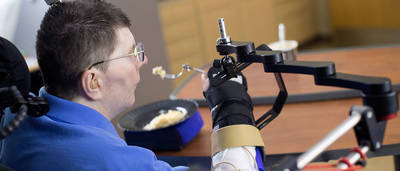
Man with quadriplegia employs injury bridging technologies to move again—just by thinking
"Bill Kochevar grabbed a mug of water, drew it to his lips and drank through the straw. His motions were slow and deliberate, but then Kochevar hadn’t moved his right arm or hand for eight years. And it took some practice to reach and grasp just by thinking about it. Kochevar, who was paralyzed below his shoulders in a bicycling accident, is believed to be the first person with quadriplegia in the world to have arm and hand movements restored with the help of two temporarily implanted technologies. A brain-computer interface with recording electrodes under his skull, and a functional electrical stimulation (FES) system* activating his arm and hand, reconnect his brain to paralyzed muscles. Holding a makeshift handle pierced through a dry sponge, Kochevar scratched the side of his nose with the sponge. He scooped forkfuls of mashed potatoes from a bowl—perhaps his top goal—and savored each mouthful." [...]
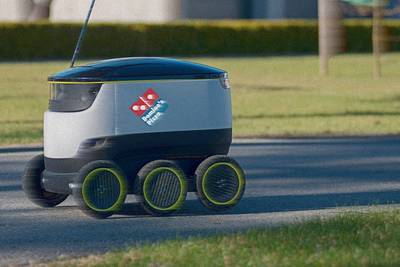
Domino’s Will Begin Using Robots to Deliver Pizzas in Europe
"Starship Technologies, the London-based company that has created six-wheeled self-driving delivery robots, will begin taking customers Domino’s pizzas in Germany and the Netherlands. Starship, launched in July 2014 by two former Skype co-founders, Ahti Heinla and Janus Friis, will whisk pizzas to customers’ doors if they live within a one-mile radius of certain Dominos pizza shops in "select German and Dutch cities," the company said in a statement. Domino’s Pizza Enterprises Ltd., the world’s largest franchise licence owner of Domino’s Pizza, with operations in markets across Asia and Europe, has formed a group called Domino’s Robotic Unit to oversee the project. Domino’s has tested ground-based autonomous vehicles for pizza delivery in Australia and New Zealand in 2016. In November it also delivered a pizza --peri-peri chicken-- by drone in New Zealand." [...]
Outras Notícias
- Panasonic Develops a Vehicular High-precision Angle Sensor
- New Single-Chip Digitally Enhanced Power Analog Solution is Ideal for DC-DC Power Conversion
- What Happens When Your PC Meets Intel Optane Memory?
- Orange Pi 2G-IoT ARM Linux Development Board with 2G/GSM Support is Up for Sale for $9.90
Ciência e Tecnologia
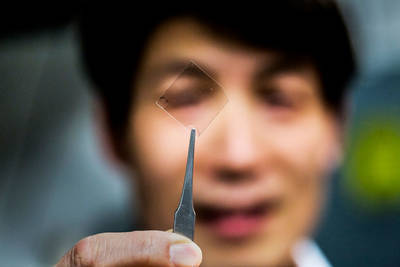
Transparent silver: Tarnish-proof films for flexible displays, touch screens, metamaterials
"The thinnest, smoothest layer of silver that can survive air exposure has been laid down at the University of Michigan, and it could change the way touchscreens and flat or flexible displays are made. It could also help improve computing power, affecting both the transfer of information within a silicon chip and the patterning of the chip itself through metamaterial superlenses. By combining the silver with a little bit of aluminum, the U-M researchers found that it was possible to produce exceptionally thin, smooth layers of silver that are resistant to tarnishing. They applied an anti-reflective coating to make one thin metal layer up to 92.4 percent transparent." [...]

Testing new networking protocols
"The transmission control protocol, or TCP, which manages traffic on the internet, was first proposed in 1974. Some version of TCP still regulates data transfer in most major data centers, the huge warehouses of servers maintained by popular websites. That’s not because TCP is perfect or because computer scientists have had trouble coming up with possible alternatives; it’s because those alternatives are too hard to test. The routers in data center networks have their traffic management protocols hardwired into them. Testing a new protocol means replacing the existing network hardware with either reconfigurable chips, which are labor-intensive to program, or software-controlled routers, which are so slow that they render large-scale testing impractical. At the Usenix Symposium on Networked Systems Design and Implementation later this month, researchers from MIT’s Computer Science and Artificial Intelligence Laboratory will present a system for testing new traffic management protocols that requires no alteration to network hardware but still works at realistic speeds — 20 times as fast as networks of software-controlled routers. The system maintains a compact, efficient computational model of a network running the new protocol, with virtual data packets that bounce around among virtual routers. On the basis of the model, it schedules transmissions on the real network to produce the same traffic patterns. Researchers could thus run real web applications on the network servers and get an accurate sense of how the new protocol would affect their performance." [...]

Organic electronics can use power from socket
"Printed electronics and organic light-emitting devices now perform at levels sufficient for a number of eco-friendly, energy-efficient applications. Previously the idea has been to drive the organic electronics using solar cells, batteries or wireless transformers, which works well in many cases. But for fixed installations like lighting, signage or UV-blocking windows, it is convenient to use a wall socket. Until now this has not been possible, because the high voltage damages the electronics. Docent Deyu Tu from LiU’s Division of Information Coding has led a project where colleagues at Umeå University joined forces to find a solution to this problem. And they have now been able to demonstrate an organic converter that makes it possible to drive organic light-emitting devices with high luminescence, and to charge supercapacitors, both using electricity from an ordinary wall socket. The converter consists of diode-connected organic thin-film transistors, operated at high voltages up to 325 V, with the capacity to transform high alternating current (AC) to a selected direct current (DC)." [...]
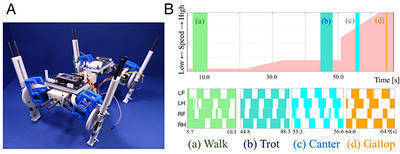
Quadruped robot exhibits spontaneous changes in step with speed
"The research group of Professor Akio Ishiguro and Assistant Professor Dai Owaki of Tohoku University have, for the first time, successfully demonstrated that by changing only its parameter related to speed, a quadruped robot can spontaneously change its steps between energy-efficient patterns (gait transition phenomena). Until now, the manner in which changing speeds cause quadrupeds to change their gaits - walking, trotting and galloping - is poorly understood. Through this study, the researchers successfully demonstrated the reproduction of the quadruped gait transition phenomena. They achieved this via a decentralized control scheme, using a simple local rule in which a leg continues to support the body while sensing weight on the corresponding leg." [...]
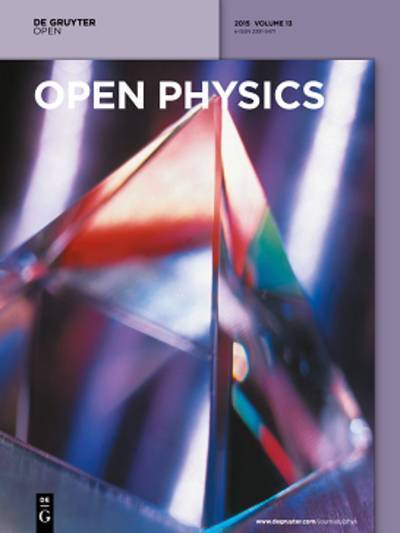
SELF-Healing Observed in Graphene
"With the first ever documented observation of the self-healing phenomena of graphene, researchers from Hyderabad, India, hint at future applications for its use in artificial skin. Graphene, which is, in simple terms, a sheet of pure carbon atoms and currently the world’s strongest material, is one million times thinner than paper; so thin that it is actually considered two dimensional. Notwithstanding its hefty price, graphene has quickly become a comer among the most promising nanomaterials due to its unique properties and versatile prospective applications. The paper by published in Open Physics refers to an extraordinary yet previously undocumented self-healing property of graphene’s, which could lead to the development of flexible sensors that mimic the self-healing properties of human skin. The largest organ in the human body, skin has been known for its fascinating self-healing properties – but until now, emulating this phenomenon proved too much of a challenge as manmade materials lack this ability. Due to unprecedented stretching or bending and incidental scratches, artificial skin used in robots is extremely susceptible to ruptures and fissures. The study offers a novel solution where a sub-nano sensor uses graphene to sense a crack as soon as it starts nucleation, and surprisingly, even after the crack has spread a certain distance. This technology could quickly become viable for use in the next generation of electronics." [...]

Apps created for everyone, by anyone
"In 2010, MIT launched its iPhone app to much fanfare from people on campus and beyond. Designed by a team led by Andrew Yu, then mobile platform manager and architect for MIT Information Services and Technology, the app provides access to the Institute’s news, campus maps, directory, shuttle tracker, emergency contacts, class locations, dining menus, and other information. Shortly following the app’s release — and inspired by its wide popularity — Yu left MIT and founded Modo Labs to commercialize the core platform, then called Kurogo, that simplifies app-building. The platform provides quick and easy access to back-end data and a simple mobile app-assembly interface, so people without programming skills can build apps and app modules. Today, Modo Labs’ platform is being used by 200 universities and colleges, as well as Fortune 500 companies and hospitals worldwide, reaching millions of users. In the near future, Yu wants the platform to be adopted by 1,000 higher education institutions and other organizations. “It’s spreading globally,” Yu says. “We’ve grown 100 percent over the last year, so we’re excited to expand.”" [...]
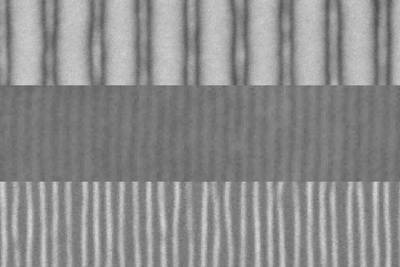
A big leap toward tinier lines
"For the last few decades, microchip manufacturers have been on a quest to find ways to make the patterns of wires and components in their microchips ever smaller, in order to fit more of them onto a single chip and thus continue the relentless progress toward faster and more powerful computers. That progress has become more difficult recently, as manufacturing processes bump up against fundamental limits involving, for example, the wavelengths of the light used to create the patterns. Now, a team of researchers at MIT and in Chicago has found an approach that could break through some of those limits and make it possible to produce some of the narrowest wires yet, using a process with the potential to be economically viable for mass manufacturing with standard types of equipment. The new findings are reported this week in the journal Nature Nanotechnology, in a paper by postdoc Do Han Kim, graduate student Priya Moni, and Professor Karen Gleason, all at MIT, and by postdoc Hyo Seon Suh, Professor Paul Nealey, and three others at the University of Chicago and Argonne National Laboratory. While there are other methods that can achieve such fine lines, the team says, none of them are cost-effective for large-scale manufacturing." [...]
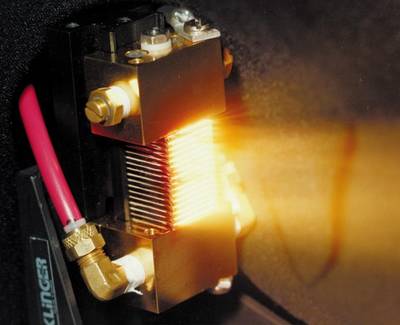
New revolutionary laser technique could lead to faster, smaller and cheaper 3D printing technologies
"A new 3D printing/additive manufacturing process using energy efficient diode lasers is set to change the way parts are produced, according to researchers at the University of Sheffield. Laser melting systems are increasingly being used in high-value sectors like aerospace and automotive to manufacture metallic and plastics parts in layers from powder. However, this process is limited as it relies on a mirror to deflect a single laser, curbing the speed of the system. The new process, called Diode Area Melting (DAM), can overcome this by melting large areas in parallel using an array of individual laser diodes. These laser beams can be switched on or off as they move across the powder bed making it faster but also more energy efficient. Dr Kristian Groom, from the Department of Electronic and Electrical Engineering, said: “Our research challenges the long held belief in the industry that low power diode modules cannot achieve sufficient melting due to their low power and poor beam quality." [...]
Documentação
A documentação é parte essencial do processo de aprendizagem e a Internet além de artigos interessantes de explorar também tem alguma documentação em formato PDF interessante de ler. Todos os links aqui apresentados são para conteúdo disponibilizado livremente pelo editor do livro.

The MagPI 56
"Incredible Raspberry Pi projects: Get into digital making with some fun projects you can try today; Power up! - The best and safest ways to power your Raspberry Pi; Hot stuff! - Make your own LED thermometer; Amazing art with Python - Use a DJ controller to mix a visual masterpiece; And much, much more!" [...]
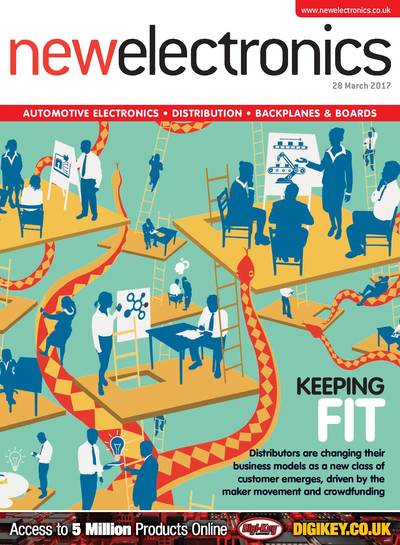
newelectronics 28 Março 2017
"New Electronics is a fortnightly magazine focusing on technological innovation, news and the latest developments in the electronics sector. Downloadable as a digital page turner or pdf file, or offered as a hard copy, the New Electronics magazine is available in a format to suit you." [...]
Projetos Maker
Diversos Projetos interessantes.
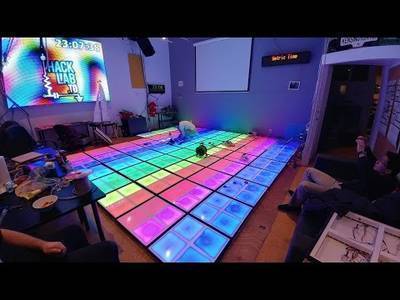
Interactive LED Dance Floor
"Recently I was involved in a project to build a giant LED dance floor for a convention." [...]

When IoT Meets AI: Home Automation With Alexa and NodeMCU
"What we will explore on this tutorial, is how to use Alexa, an intelligent personal assistant developed by Amazon Lab126, made popular by the Amazon Echo and Echo-Dot. Alexa is capable of voice interaction, music playback, making to-do lists, setting alarms, streaming podcasts, playing audiobooks, and providing weather, traffic, and other real time information. Alexa can also control several smart devices using itself as a home automation hub. We will use on this project, the "Echo-Dot", that allows users to activate the device using a wake-word (such as "Alexa"). In the home automation space, Alexa can interact with several different devices as Philips Hue, Belkin Wemo, SmartThings, etc. In our case, we will emulate the WeMo. WeMo is a series of products from Belkin International, Inc. that enables users to control home electronics from anywhere. The product suite includes a switch, motion sensor, Insight Switch, light switch, camera and app. The WeMo Switch (our case here) can be plugged into any home outlet, which can then be controlled from an iOS or Android smartphone running the WeMo App, via home WiFi or mobile phone network." [...]

Controlling Brushless Motor With Arduino
"Greetings fellow Instructables Readers,Makers,Geeks,Hobbyists,Electronics Enthusiasts and Beginners; For quite some time now, I had been wanting to make a Wireless R/C car using Brushless Motors and Arduino.It was now that I got over with my school exams that I actually decided to make it.During the finalisation of the control method i was going to use in order to make the R/C car, I came across a problem:Controlling Brushless Motors With Arduino. While controlling a (Technically) AC motor with Arduino seems a bit intimidating,worry not, since in this instructable,I am going to show you how easy it is to control a Brushless Motor Using Arduino using any kind of Switch/Potentiometer/Joystick, basically anything that can vary a parameter in such a way which can be recorded by the Arduino,whether its directly voltage or resistance." [...]
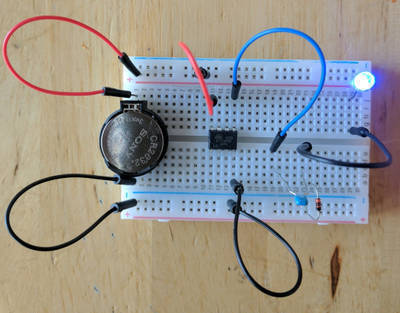
Blinking Blue- Powering a 3.7 volt LED from a 2.4 volt coin cell with a $0.02 charge pump
"Everyone loves blue LEDs and everyone loves coin cell batteries, but if you want to power a blue LED from a coin cell you will need some help. Here is a super-cheap and easy way add a to boost your LED voltage with only an additional capacitor & diode, and a little software. I love that Atmel AVR chips (ATTINY, ATMEGA, Arduino) can run directly on battery voltages from 1.8 volts up to 5.5 volts. I also love that they can drive LEDs directly connected to their IO pins. If you connect a ATTINY directly to a CR2032 and a red LED and blink your life away until the battery is almost completely dead. Most blue LEDs need more than 3 volts to light up. A brand new CR2032 coin cell makes about 3.2 volts on a good day, and it is all down hill from there. So how can we light a blue LED from a coin cell?" [...]
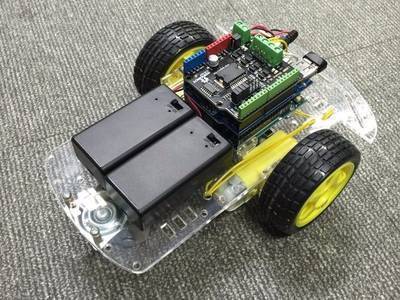
DIY RC Car
"Web-based Car Control with PHPoC Shield for Arduino. " [...]
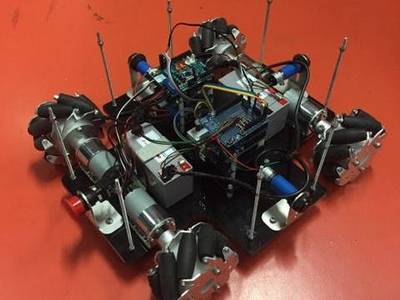
NAMLA
"NAMLA Robot Mahmoud Sabra, Mohammad Kassab and Nur Irem from Bahçşehir University are building an autonomous omni-mobile robot , and they named it NAMLA. NAMLA has: Manual Control: It can be controlled via joystick. PTP, Point to Point: It can go from initial point to destination through the shortest route." [...]
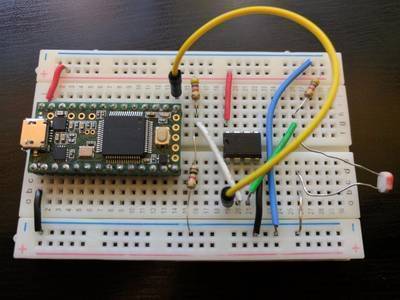
Quick Tachometer
"This easy project was developed to test the top speed of a stepper motor controlled by an Adafruit Motorshield as part of a class assignment (University of North Carolina at Charlotte's Junior Design). After throwing it together, we quickly realized that this became an important diagnostic tool for a larger project. The larger project requires the use of stepper motors, controlled by an Adafruit Motorshield v2. Initially, we used this tachometer to test the top speed of the motors (with no load) to compare against manufacturer specifications. However, we found that this served nicely a code-verification tool as well. When a desired motor speed was programmed using a variety of available libraries, we found that the actual motor speeds differed significantly. Since the larger project is a time-based competition, this had significant implications for our end performance. We decided that we could use this to reconcile our programmed speeds with actual speeds rather than spend countless hours trying figure out why we weren't reaching the speeds we expected. And, in the spirit of good sportsmanship, we wanted to share this with others that might find this as useful as we have. With some slight adjustments to the code, this project can be adapted to many platforms. Generally, the only difference between most platforms and the Teensy is the way the interrupts are attached. I just happened to have a Teensy 3.2 sitting around, collecting dust." [...]

Password Manager, Typer, Macro, Payload ... All in ONE!
"Often I need to log in to my mail accounts or to log in to my University profile from a pc that is not mine. I tipically use 10 characters or more password using numbers, symbols, upper and lower case letters. A nightmare to remember and even worse to type in right at first try. And sometimes one of my relatives have problems remembering a password, such as wifi or similar stuff. So I came up with this new idea. PassType (yeah... I like to give names to the stuff I build, this name comes from the contraction of "password type in device") is a very cheap and simple to use password manager, capable of storing more than 250 passwords and to type them in every device! It works with every computer and it can even be plugged and used on smartphones. Every system supporting some sort of keyboard is compatible with PassType. This device has a small joystick-like 5-way tactile switch as input method. The small OLED display shows a functional and intuitive UI (user interface). All the datas are stored in a 32kb EEPROM. PassType is powered by an arduino Pro Micro. Pentesters or computer enthusiasts will be happy too because this small device can be used to perform tasks that are boring, repetitive or to type in hundreds of characters in few seconds. Actually it can do everything that a human in 15 minutes can do with mouse and keyboard in only few seconds. In this project I'll use a 32K EEPROM memory, but you can use even a bigger one. See the last step for further development." [...]
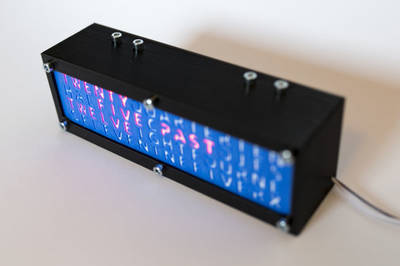
Mini Word Clock
"I have seen several nice word clock designs here in Instructables and other places. Somehow, I’m always fascinated from the clocks and I wanted to build mine. After long time thinking I found a nice way that I thought would be the easiest. First, I thought how could I make the word panel. Basically, all the designs I have seen are using fancy vinyl or laser cutting. I dint have access to either of them, but I have 3d printing access. So, that made fixed the first problem. Second problem. How to light up proper letter. I thought about using a PCB and soldering LEDs on it. Coincidentally on that time I saw a LED matrix modules. That gave me an idea- why don’t I use the LED matrices. The control can be very easily made with an Arduino and here is very little soldering needed. I don’t have any problems with soldering, but I was looking a way to reduce time consuming work." [...]
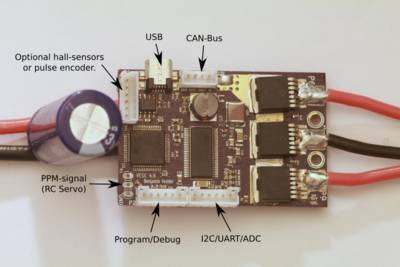
VESC – Open Source ESC
"I have made many updates to my custom motor controller recently and the old post is getting confusing with notes and updates, I decided to write a new post about it that hopefully is more clear, more complete and easier to follow. This might sound a bit ambitions, but my goal is to make the best ESC available. I really enjoy sharing knowledge, so I want to keep all the hardware and software open." [...]
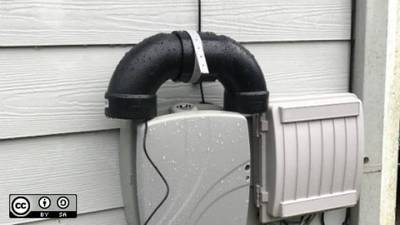
How to build a smog sensor with a ESP8266 microcontroller
"A city in Germany is developing their own IoT sensors to measure air quality to help combat the smog problem. Stuttgart, Germany has, like many other cities, a smog problem—even if it may be less severe than in other cities. The European Union has defined a threshold of on average 50 micrograms of dust particles per cubic meter in a 24-hour window of air to be allowed for a maximum of 35 days a year. For the last few years, actual values have been much higher for more than 35 days. There are governmental stations that measure the air pollution, but they can’t be everywhere for obvious reasons. The Open Knowledge Lab in Stuttgart, Germany has begun to develop their own IoT sensors that measure air quality every minute and report the data to a central server. It is then possible to display the smog levels on a map. See the map we're using." [...]

Arduino Colorful Clock++ Using Neopixel Strip
"Features of the clock: Arduino micro-controller based; Hardware & enclosure procured from local stores; RTC controlled by battery; All functions controlled via IR remote control.; Multiple modes of Display: Dot mode, Seconds arc mode, Minutes arc mode, Hours Arc mode, All Arc mode, Night mode(Auto dim); Hour alerts and auto mode change every 15 minutes; Senses low ambient light and dims the LEDs to very low light levels; Ambient light level adjustment to go to night mode." [...]
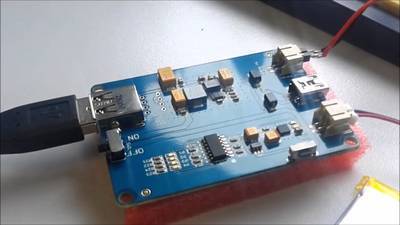
NodeMCU Home Weather Station
"Make your own home weather station. The device measures temperature, humidity and light. All data are send to a website name Ubitos.com. " [...]

Mechanical Moving Map for Bikes
"Actually it is a GPS portable unit so it can be mobile on just about any method of transportation but fat bikes traveling on wilderness snow routes here in Alaska seems to be fun use for it right now. But feel free to build one for car, snow machine, dogsled, or helicopter. My last project involved analog speedometer--https://www.instructables.com/id/Bike-Analog-Speedometer/ so I thought it would be a good project to build it into a mechanical moving map display. The concept is old--see photo above of 1930's era speedometer attached moving map for a car. And everyone remembers the neat moving map display in 007's Astin Martin in Goldfinger. Just like mechanical watches have their OCD champions attentive to the fussy gearing on their wrist you can now luxuriate in the slow meandering walnut-humming-chuckle of gear-motors driving a divining pointer over your hand assembled map! It is a relatively easy project with just a few parts from the usual electronic stores. The coding is all Arduino IDE and the hookups just require the minimum wiring skills. The case for the instrument can be build multiple ways and people with machining or 3D print access probably can build something different." [...]
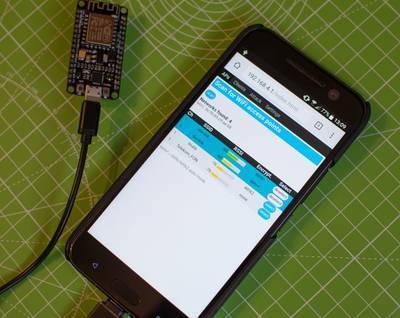
ESP8266 Deauther
"Basically it’s a device which performs a deauth attack. You select the clients you want to disconnect from their network and start the attack. As long as the attack is running, the selected devices are unable to connect to their network." [...]

How to Maek Game of Life Using ATtiny13A and Mini Breadboard
"I challenged making a Conway's Game of Life at 1 KB using ATtiny13A.Used to display MAX7219 Dot Matrix Module LED Display Module.Because ATtiny13a does not have a pin for displaying the Game of Life.And using MAX 7219 makes the circuit very simple." [...]

SMARKANT - Convert your IKEA Bekant table into a smart IoT device
"This work extends the IKEA-Hackant project from Robin Reiter , who reverse engineered the controller board of an IKEA Bekant motorized adjustable table. He added an Arduino board and four buttons to the controller, so that you can store two table positions and easily recall them. You can find Robin's work in his GitHub repository . This Video shows his project development and the operation of the modified table. Robin has already explained how the Bekant controller and his Arduino circuit works. So please refer to his documentation, if you want to learn more about this. In a nutshell: the current table height is received as packets on a LIN bus and the table motor is controlled by simulating presses of the original up and down buttons of the controller." [...]

Arduino Digital Clock Version 2
"Shown in this video, I have created an Arduino UNO large clock on 16x2 character LCD display shield with the ability to change hours & minutes and turn on/off the back light." [...]
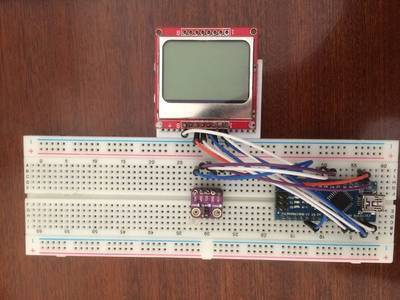
Control the Arduino With Gestures
"Hi there! Today we are going to make a Gestrure Controlled Arduino! So, we want to when we slide our hand to left, see the ''LEFT'' word on the 5110 screen. So with this Arduino code we will learn the How we use the Apds-9960. So, if you want control a robotic arm with this sensor you can it. We learned Color feature this sensor." [...]
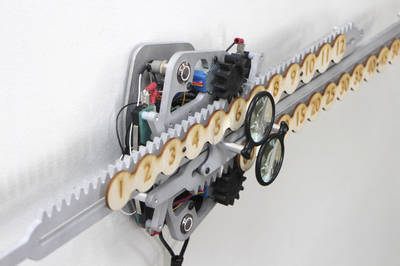
Perpetual Clock With Arduino
"No matter what Deepak Chopra tells you, time is linear. Hopefully this clock is a little closer to reality than the circular ones we're all used to. The five minute intervals feel less neurotic than being precise down to the minute, and each number is magnified, reminding you to focus on the present. I made this using just about every machine at Pier 9 (waterjet, sand blaster, laser cutter, 3D printer, electronics lab, etc.). It's made of 6061 aluminum, steel hardware (screws, nuts, bearings), 3D printed gears, an Arduino Uno, and the hour and minute panels are laser cut / etched plywood. Of course I know this project isn't accessible to almost everyone who doesn't have the insanely good fortune of having access to a shop like this, but hopefully you'll find it inspiring." [...]
We built a giant pixel wall for fun, but what we learnt went a lot further
"Every tech company has side projects and Solid State is no different. It keeps devs motivated and flexes the bits of the brain sometimes not quite reached by day to day coding. Sometimes these side projects become products, sometimes we crack open a beer and ask “what the hell were we thinking”, but always we learn something - about the process, and perhaps ourselves. We’ve been deep in client software dev projects for months and decided the next internal project needed to be a physical thing - BUILD THE WALL we cried aloud. Well, in truth, we shouted this over Slack, until the pixel wall became a thing. As this thing took shape over the weeks I realised that despite all the cool tech, the late night coding and problem solving, it was never just about the wall. Here I’ve documented what we did, what we learnt and how I feel about the project." [...]
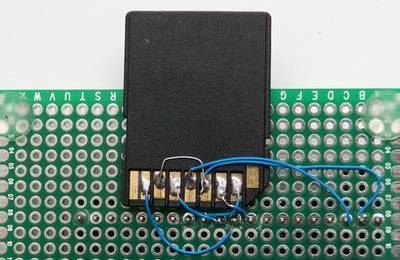
SD cards with FAT files
"Those little plastic µSD-to-SD card adapters, of which you may have a bunch lying around since they are often included with new µSD cards, make excellent µSD card sockets: There are many libraries (in C for the Arduino, for example) which support accessing SD cards from an embedded µC. These all rely on a well-known feature of these cards of supporting SPI: The only tricky bit is getting them into that mode. For this, the SPI clock has to be temporarily lowered to 100..400 KHz, and then a few magic pin toggles and byte sends will do the rest." [...]
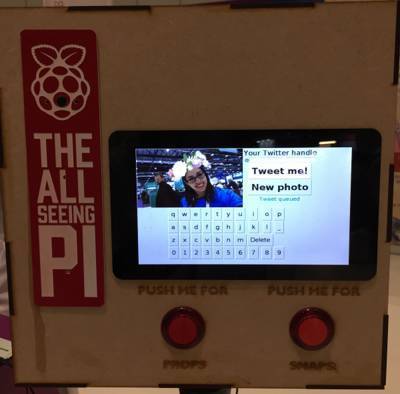
The All-Seeing Pi
"In this resource, you will make a tweeting touchscreen photo booth using a Raspberry Pi." [...]
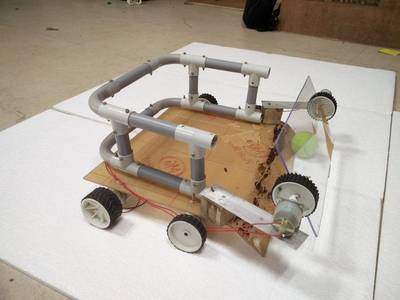
A.B.C(Automatic Ball Collector)
"Been tired of picking Ball while playing Tennis, this is what you will Love. This is Tennis Ball Collector which is programmed to collect a ball in a tennis court, allowing you to focus on your game only.It sees the world around it through a camera where image processing has a vital role to play.Though this is in it's early phase but after some evolution, it will be ready to be brought in court." [...]
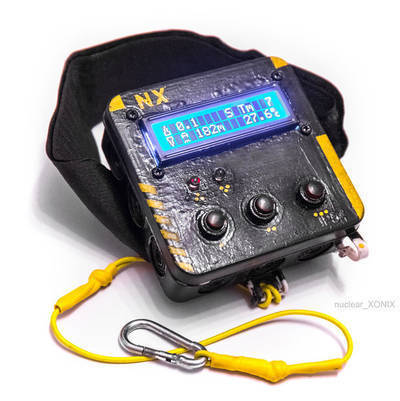
DIY Arduino Variometer for Paragliding
"All paraglider and hang glider pilots can be devided into two categories: those who have the variometer and those who want to have it. In this post you'll see, how you can make such device with your owh hands and not pay a lot of money. Of course, the DIY device will not have such precision as the factory one, but it's still enough for flights." [...]
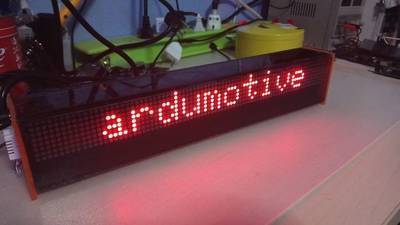
DIY Arduino LED Matrix Display - 80x8 Px
"In this instructables guide I will show you how to make your own Arduino LED Matrix display! Main Features: Time; Day of the week; Date; Temperature and Humidity; Ticker Text; Adjustable brightness level; Bluetooth communication" [...]
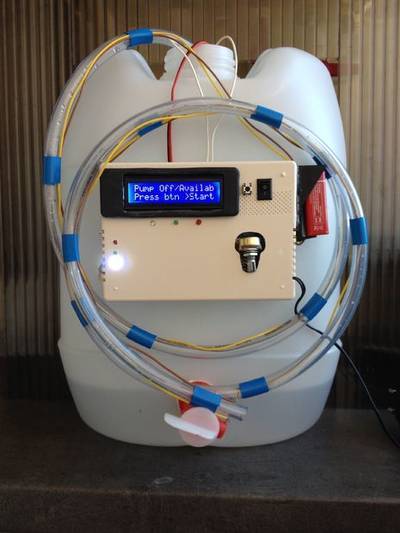
Arduino Controlled Pump for Draining Water
"The idea of this project came out when I bought a condensing gas boiler for my apartment. I don't have any drain close by for the condensed water the boiler produces. So the water is collected in a 20 liter tank (drum) for few days and when it gets filled up, i have to discharge it manually. So I decided to make an Arduino controlled pump which will discharge the water with only one push of the button. A display shows the status of the pump. I've added two level sensors to stop the pump if the drain is either overflowing or the level is dropping inside the collecting tank. This is important for the well functioning of the pump, in order to always be submerged." [...]
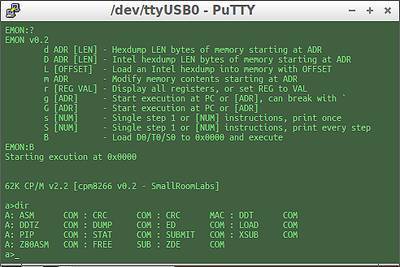
CP/M 8266
"Z80-CP/M 2.2 emulator running on ESP8266. This is my attempt to run CP/M 2.2 for Z80 softwares on an ESP8266. The CP/M machine have 64K RAM, 15 floppy drives @ 250KB each and an autobauding serial port as a console device. Since the ESP8266 only have 96KB of Data RAM and even when runnig the "NONOS-firmware from Espressif the free heap, after the WIFI & TCP/IP stacks are loaded, is less than 48KB which was my minimum goal for CP/M RAM. Luckily the nosdk8266 project from cnlohr solves the RAM issue. By using the it I get more than 80KB of heap which is more than enough for the 64KB RAM in the Emulator. But this unfortunately comes with a cost - namlely no wifi. Not really a showstopper for me, but it would have been nice to be able to just Telnet into the CP/M machine to connect to the emulated terminal. But not all hope is lost for those who want wifi and telnet - I'm currently patching in an option to compile a version with about 36K RAM, wifi and one less floppy disk." [...]
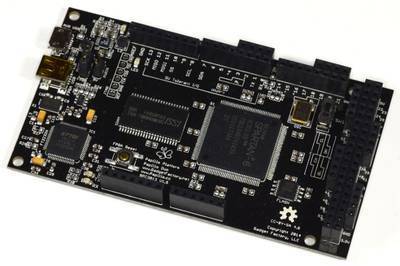
A Microcontroller Enthusiast’s First Look at Programmable Logic
"The field programmable gate array (FPGA) has traditionally resided in the world of high-end professional development. Until recently, FPGAs stayed almost exclusively in that arena because of the high initial cost to purchase, the expense of the development tools, and the mystery surrounding the concept. Luckily, in recent years, much of that’s changed. There are now quite a few reasonably priced and easy to use FPGA development boards, and the basic tools can often be downloaded for free. A few of these boards were noted in a previous article: “The Best FPGA Development Board for New Designers.”" [...]

Build a Simple Cocktail Drinkbot with Arduino
"Big parties need a conversation piece, and what’s better than a drink-making robot? Not only is it a good conversation starter, it also frees up the party host who would normally be the bartender. It turned out that the drink robot was a really good idea. The Mai Tai recipe presented here has the alcohol dialed back making it a good idea for a work party. The robot is really an Arduino microprocessor (Uno version) that controls a number of pumps. A simple program allows the pumps to turn on for the required time to make a mixed drink. The machine is set to make one drink, but the programming and input switches can be changed to hold dozens of drinks. The idea here, is to get building and understand the basic concepts to make your own drink robot." [...]
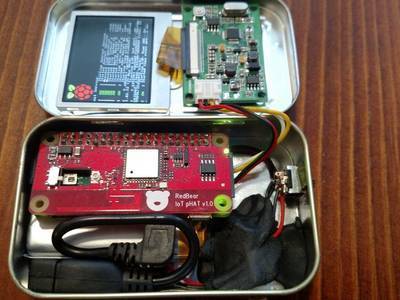
PiMiniMint
"The idea of having a computer in an Altoids tin came to me back when in early 2012, shortly after the original Raspberry Pi came out. With the release of the Pi Zero, this became a possibility. The first version of the PiMiniMint contains a screen, Wi-Fi, Bluetooth, 32GB of storage, an infrared camera, and a full-sized USB port. When I decided to add a battery, I realized the camera needed to be removed. The current vision of the PiMiniMint contains a battery life of around 6-8hrs, a 2" screen, 32GB of storage, Bluetooth, Wi-Fi, and a full-sized USB port (in the form of an OTG cable)." [...]
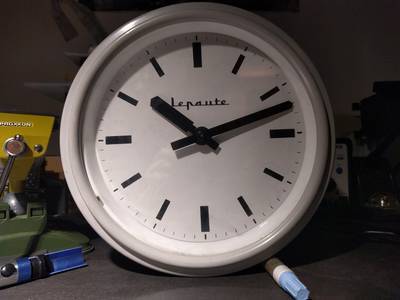
masterclock
"Slave clocks are old school clocks mostly used in train stations, hospitals, factories, etc... places that needed to have accurate timekeeping and synchronized clocks in a lot of places. A master clock was responsible for keeping time and controlling all the slave clocks. There were a number of clock manufacturers, and there were a lot of way of synching the slave clocks to the master clock." [...]
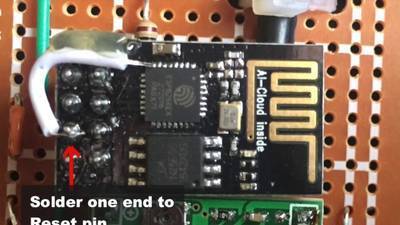
Enable DeepSleep on an ESP8266-01
"We all know how versatile the ESP8266-01 is. By "we", of course I mean the 6 people that are still reading this after seeing the title! Sure, it does have its limitations: only 2 GPIOs; no analog GPIO; inability to use the ESP.deepSleep() function; We've looked at getting more GPIOs before here. We'll look at analog options another time. But in this Instructable, we'll deal with the Deep Sleep issue." [...]
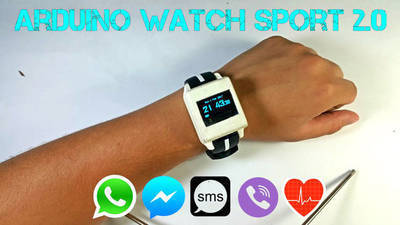
DIY Arduino Watch Sport 2.0
"A year ago publish the design and implementation of a clock known as Arduino Watch Sport 1.0, and my only goal was to recycle some materials that usually go into a basket of rubbish, the result of carrying out this project was a clock with the following features." [...]
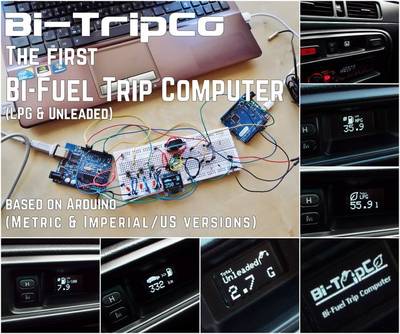
How to Build a Bi-Fuel (LPG & Unleaded) Trip Computer Using Arduino
"The main reason I made this project is the lack of a trip computer that is designed for LPG powered cars. I named it Bi-TripCo as it can measure the fuel consumption for both fuel systems of a Bi-Fuel car (LPG and Unleaded). Some might say: "ok, a similar one, no big deal!". Don't rush.There are many (or some) tools out there, that can calculate the consumption of conventional fuel systems, which are very easy to use: just plug it into the OBD port of your car - unless you have an older car which does not have one, like mine. And, of course, there are some very good implementations based on Arduino, which can calculate many things related to the Unleaded fuel consumption. But those tools can not be used on an LPG powered car. " [...]

Writing a Raytracer in Rust - Part 1 - First Rays
"ello! This is part one of a short series of posts on writing a simple raytracer in Rust. I’ve never written one of these before, so it should be a learning experience all around. So what is a raytracer anyway? The short version is it’s a computer program that traces the paths of simulated rays of light through a scene to produce high-quality 3D-rendered images. Despite that, it also happens to be the simplest way to render 3D images. Unfortunately, that comes at a cost in render time - raytracing an image takes much longer than the polygon-based rendering done by most game engines. This means that raytracing is typically used to produce beautiful still images or pre-rendered video (eg. Pixar’s RenderMan technology)." [...]
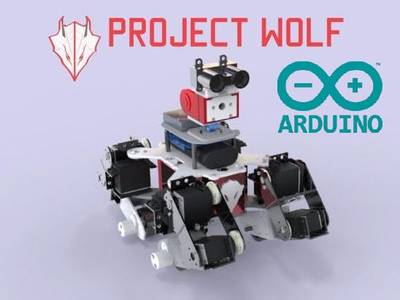
Wolf: Search and Rescue Multi-Terrain Robot
"The concept of this robot design is to create a quadruped that can easily transform between walking mode and rover mode (aka wheel traversing). The walking mode will be used for operations that are not ideal for wheels such as scaling a vertical wall or traversing over extremely uneven terrain. The rover mode is used for flat terrain and faster traveling time. The robot is controlled wirelessly via Wifi through a web page that I made exclusively for this robot. Beside the transforming capabilities, I also added an IMU sensors, GPS, and Lidar for self-orientation and autonomous functionality. In this project, the Arduino 101 is used as the muscle control cortex. The Arduino 101 do calculation and control all the servo on the robot and transmit and share this data with the Raspberry Pi 2. The Rapsberry Pi 2 on the other hand will focus on transmitting video to the webpages and broadcast sensor data to the cloud for analyzing. All the data is logged via IBM Watson and Node Red services and can be easily review in graph format for data analytics.The goal of this project is to create a low-cost multi-terrain traversing robot prototype for search and rescue operation." [...]
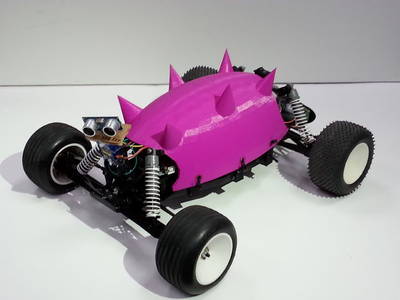
How to Make an Obstacle Avoiding Car With Arduino
"Last year we attempted to make a tank with arduino. Theoretically, she would have been controlled with an infra-red remote and also have been the coolest little car on the block. Her name was Bessie, and she failed miserably. She was barely controllable and her gears would become misaligned on a regular schedule. We vowed not only to never touch an IR receiver again, but also to do better next time. Thus, Bessie's son was born. His name is Eisseb (see what we did there). Eisseb is our obstacle avoiding car. He began as a fancy RC car chassis, and with some modifications, plus an arduino uno and a sonic sensor, he became what he is today: awesome. BUT WAIT! There's more: We did the work, so you don't have to! Okay, that's a lie, but we did write down what we did. Hopefully, the world will soon be full of sonic sensor cars for Eisseb's robot army." [...]
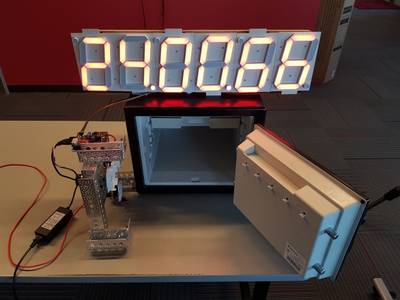
Building a Safe Cracking Robot
"My wife is amazing; for Christmas this year, she gave me a fire safe she purchased off of Craigslist. It was super cheap because the seller didn’t have the combination. Best present ever. We were able to crack our Craigslist safe in 40 minutes and 42 seconds! You can re-watch the live cracking if you’d like. The magic moment occurs at 45:20 but start around 44:30 to get the full scope of what’s going on. Brute force robots for combination safes are not new. They are sometimes called an “Autodialer”. And the robots that use audio feedback are sometimes called “SoftDrill”. The SparkFun Safe Cracker is a variant of the Autodialer. Instead of attempting every combination in the solution domain (called brute forcing) we use some tricks to reduce the domain and shortcuts to speed up the testing process. In addition, the SparkFun Safe Cracker is cheap (~$200), magnetically adheres to the safe, and is non-destructive; when we’re done you’ll never know we were there." [...]
That's all Folks!


